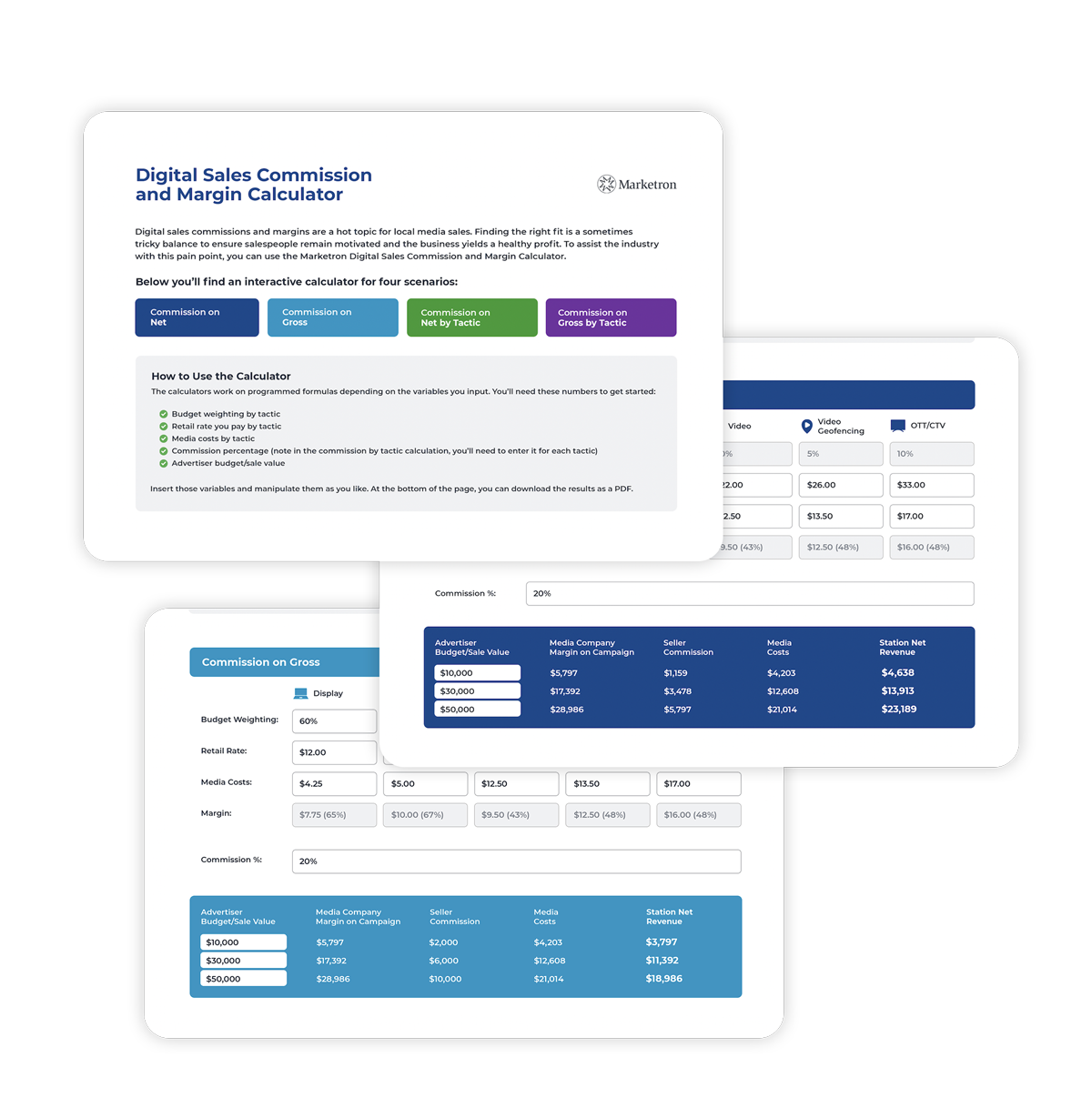![]()
The Ultimate Guide to Digital Sales Compensation for Media Companies
Digital sales compensation is a primary concern and topic of conversation for every media company. No matter how mature your digital sales strategy is or your success, compensation and commission for sellers are pivotal to recruitment, retention and revenue growth.
With so many models to use, many sales managers feel overwhelmed and unsure how to incentivize sellers while ensuring healthy margins. The world of digital sales commissions is much different than linear and O&O (owned and operated) inventory, yet it needs to work in concert with your linear commission strategy. It’s complex.
In this guide, we’ve put together information, data and insights to help you navigate digital sales compensation.
or continue reading.

The Basics of Digital Sales Compensation
First, let’s talk about the big picture of compensation. Sellers can either earn a straight commission or salary plus commission. Media companies use both options. It’s the first decision to make for sales compensation. High performers are often drawn to straight commissions because they can make more money. These veterans realize its benefits. In the Center for Sales Strategy’s Media Sales Report, 52% of salespeople said they prefer salary plus commission, which was down 8% from the previous year. The majority still favor this structure. What you choose will depend on the size of your sales team, their experience and how attractive commission rates are.
The second foundational piece of the compensation conversation is digital. It differs from linear and O&O, and it needs its own framework.
There’s more competition for digital ad budgets than linear. As a result, your sellers must often do more prospecting and proposing to win deals, and advertisers are usually more price sensitive.
Digital encompasses many different tactics, each with varying retail costs and margins. Sellers must also gain knowledge and proficiency in these tactics.
Digital has a higher cost of goods versus linear and O&O.
Sellers have to do more work in selling digital. Along with honing their skill sets on tactics and strategy, they may have to facilitate ad ops or administrative tasks.
Based on these reasons, you can see how complex compensation is in digital sales. You have to consider all these factors when deciding what model to use.
What Models Do Most Broadcast and Media Industries Use?
As you evaluate the options, it’s good to know what the industry is doing. According to the 12th annual Borrell-RAB digital benchmarking report for radio, these are the most common models:

These are the primary structures most media companies use, but that doesn’t mean they are the best choice for you. Let’s look at the pros and cons of different models.
Compensation Models Explained with Pros and Cons
Here’s a review of the most popular models and the pros and cons of each.
Commission on Gross Sales
Sellers receive a commission based on the gross value of the total sale.
(hover)
Pros
- Calculations are easy.
- It encourages solution selling vs. margin selling.
Cons
- Gross doesn’t account for retail costs, so the revenue for the station could be less.
- Leadership may discourage it to protect margins.
Commission on Net Sales
Sellers receive a commission based on the net value of the total sale.
(hover)
Pros
- Net accounts for the retail costs of executing digital ads, so it’s less likely to impact margins.
- It’s the most popular model, so sellers are familiar with it.
Cons
- Sellers may be dissatisfied with the lower amount.
- Calculations are more complex.
- It may discourage sellers from selling low-margin tactics.
Commission Per Tactic (Gross or Net)
Each tactic they sell (e.g., display, video, geofencing, OTT, etc.) has a different weight for commission.
(hover)
Pros
- It can incentivize sellers to add more tactics to a proposal, which can positively impact campaign performance and advertiser satisfaction.
- Margins are consistently fair across tactics.
Cons
- Sellers may only recommend the tactics with the highest commission rather than what will help an advertiser meet their goal.
- It’s complicated to calculate and track.
Tiered Commissions
Sellers must deliver a certain number of digital orders or new business to increase their commissions. This may reset annually.
(hover)
Pros
- It’s a good motivator for new salespeople to include digital in all proposals.
- A concerted focus can ensure you hit target numbers.
Cons
- There are more fluctuations in payouts, which could impact cash flow.
- It may be a short-term incentive.
Ad Hoc Commission
This option mixes different models.
(hover)
Models
- Paying higher commissions at the beginning to incentivize and account for extra work sellers must do to build a book of business
- Raising commissions after an “introductory” period
- Increased commissions on renewals
- Higher commission rates on new business
Pros
- It can align with where the organization is in its digital maturity.
- Ad hoc can help sellers give equal value to new and existing business.
Cons
- It’s hard to manage and scale.
- Some sellers may fall off in production after moving to a lower tier of commissions.
Reviewing these pros and cons is a good starting point for choosing a compensation model. What other factors should you consider?
Selecting a Compensation Model: What to Consider
When weighing your options, these are questions to answer.
What is your digital maturity?
In the beginning, it makes sense to pay higher commissions to incentivize. Once digital becomes a reliable revenue, you should reassess. You may also consider an introductory period for new salespeople.
How knowledgeable are your sellers?
If they are digital novices, they will need training, education and possibly greater incentives. For more seasoned sellers, their commissions should align with the value they bring as a result of their knowledge. To retain high performers, you’ll need to be competitive while balancing the need to grow revenue.
What is your station’s digital revenue goal?
Your commission structure should align with the expected revenue you’re budgeting for. This alignment must involve seller feedback on goals and what’s reasonable. If the numbers are too high compared to previous years or what your local market can produce, sellers may feel it’s unrealistic to hit these, which can lead to disengagement and churn. On the other hand, if it’s too small, the incentives may not be enough motivation, resulting in missed revenue.
What resources are you providing your team?
If sellers don’t have support for ordering and executing digital ads, they must do more work. Thus, you may motivate them with larger commissions. As you build out your operations with technology, they’ll have fewer burdens, and that’s a time to reconsider percentages.
What do your sellers have to say?
Getting feedback from your sales team should influence your decision. Making them part of the discussion shows you want to keep them motivated and happy. After all, compensation has much to do with recruitment and retention.

The Connection Between Compensation, Recruitment and Retention
Media companies rank recruitment and retention in sales as a big challenge. In fact, 65% of sales managers said it was the hardest part of their job, and 73% relayed that they don’t have the right number of people. Many factors are driving these opinions, including:
- It’s a tight labor market, and salesperson is an in-demand job.
- Salesperson turnover is prevalent, averaging 35%, which is much higher than other roles. The number leads to high costs to fill roles, which can be one-half to two times the employee’s salary.
- Younger generations entering the job market aren’t joining the industry, and veterans are retiring. That’s creating shortages.
As a result of these factors, the industry needs to make sales an attractive job, and part of that is compensation. First, you need to define and measure if you’re “competitive.” That involves reviewing:
Local economy
Cost of living
Benchmarks
What you can afford
Offerings beyond monetary
(PTO, benefits, etc.)
Second, you’re better off being transparent about pay from the start. It matters and can influence whether someone even applies. In fact, 85% of recent graduates said they are less likely to apply for a job if compensation isn’t disclosed.
Third, in the interview stage, when conversations about compensation occur, you should discuss how you evaluate and update models. They need to know that this isn’t the structure you’ll use forever and how you assess compensation from year to year.
Hiring is only one part of the ecosystem. You also want to retain high performers, ensuring they continue to work within models that compensate and incentivize them effectively. You can mitigate the turnover turnstile by continuing to be honest and open.
Additionally, keep in mind that compensation is critical to incentivizing and motivating sellers, but people respond to more than just money. A healthy culture, consistent communication, acknowledgment of good work, flexible schedules and benefits are often more important. Keep all these things in mind to ensure sellers feel valued and appreciated.
Commission Models and Hitting Digital Sales Goals
How you compensate sellers for digital sales directly impacts an organization’s ability to meet its objectives. For stations to succeed here, you need to rethink sales goals and commissions. Isolating digital in terms of goals and commissions is imperative to keeping everyone motivated and incentivized.
Target numbers should be in place for the entire sales organization, from leadership down to the account executive. The absence of this causes many sellers to fall back into what’s comfortable and most lucrative. By implementing digital-specific goals, you can grow revenue for the organization as you capture more dollars from advertisers.
Everyone’s on the same page and marching toward the same goal. It benefits everyone in the organization when there’s clarity and transparency around compensation.

Explore Compensation Models with the Digital Sales Commission and Margin Calculator
You can experiment with four different commission structures in our interactive calculator: commission on net, commission on gross, by the tactic net, and by the tactic gross. Simply click the below button to visit the calculator page. You’ll find instructions and be able to download your calculations.


